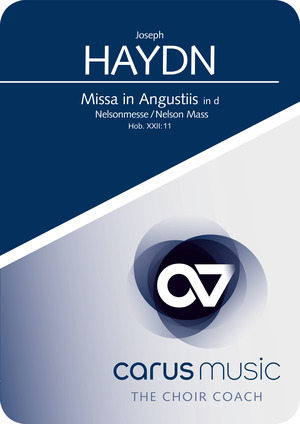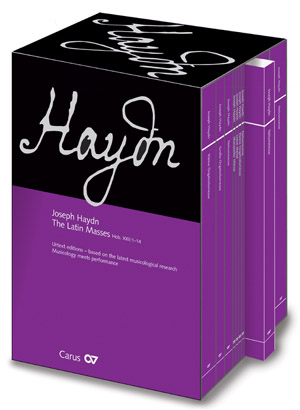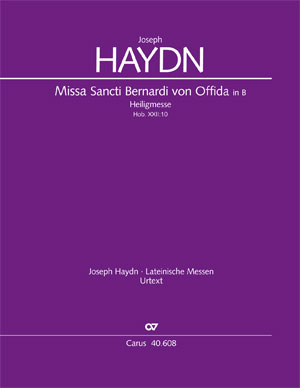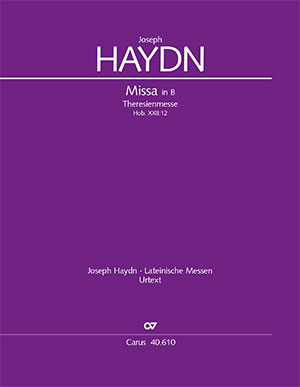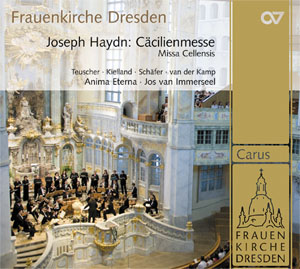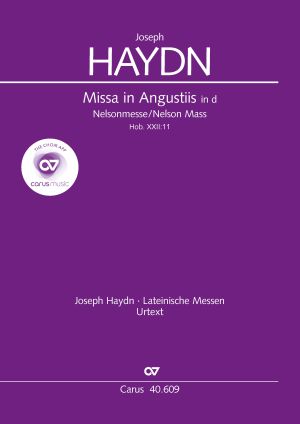
-
Composer
Joseph Haydn
| 1732-1809As Kapellmeister to Prince Esterházy, Haydn composed numerous instrumental works and various operas, as well as making important contributions to the genre of church music, including fourteen Latin masses, of which only twelve are authentic or complete; these are complemented by motets and offertories, two important Te Deum settings, two Salve Reginas, a Stabat Mater, and the different versions of the Sieben Worte des Erlösers am Kreuze. The masses were composed continually between 1749 and 1802, except for the years 1783–1795, and therefore constitute the genre with which Haydn was occupied over the longest period of time. The six (authentic or complete) masses composed before 1782 are stylistically very different, and as well as short Missae breves there are more extended masses with rich orchestral scoring; by contrast the six so-called late masses, written from 1796 onwards, form a comparatively homogeneous group of more extensive works scored for large forces. With his two great oratorios Die Schöpfung (The Creation) (1798) and Die Jahreszeiten (The Seasons) (1801) Haydn established the tradition of the German oratorio for middle-class music making. Personal details
-
Editor
Wolfgang Hochstein
| 1950
Reviews
Joseph Haydn: Missa in Angustiis
Joseph Haydn: Missa in Angustiis
Zwischen den beiden großen Oratorien, der Schöpfung und den Jahreszeiten schuf Haydn als drittes der „Hochämter” im Sommer 1798 die Missa in d-moll. Der Name „in Angustiis” reflektiert die damalige politische Situation in Europa während der Koalitionskriege. In der Nelson-Messe, wie auch in der so genannten „Paukenmesse” (Missa in tempore belli) sind kriegerische Trompetensignale und Marschrhythmen anzutreffen. In der originalen Instrumentation ist von Haydn, neben den Streichern und der Orgel, ein Trompetensatz von drei Trompeten und Pauken vorgesehen. Die dritte Trompete hat dabei eine reine Verstärkungsfunktion im Tutti und ist überdies nur im Kyrie und Benedictus vorgesehen. Die Orgel ist über die Generalbassfunktion hinaus auch mit solistischen Aufgaben ausgeschrieben. Erst 1803 kam die Messe mit erweiterter Bläserbesetzung heraus, bei der die solistischen Orgelpartien auf Holzbläser und Hörner, nicht von Haydns Hand, aber in dessen Auftrag, übertragen wurden. Die vorliegende Ausgabe gibt Holzbläser- und Hörnerstimmen ebenfalls wieder, doch hat die Originalinstrumentation durchaus großen Reiz und ist zudem, wegen des geringeren Besetzungsaufwands, wirklich „aufführungsfreundlich”. Partitur, Klavierauszug, Chorpartitur und das gesamte Orchestermaterial für alle Besetzungsvarianten liegt in schönem Druck beim Carus-Verlag vor.
Quelle: Musica Sacra 2/92, S. 161f.
Die sechs großen späten Messen Haydns verlangen neben vier Solisten und dem Chor einen verhältnismäßig großen instrumentalen Apparat (3 Trompeten, Pauken, Streicher, Continuo und Flöten, 2 Oboen, 2 Klarinetten, Fagott und 2 Hörner ad libitum). Die Messe ist im schwierigen Jahr 1798 entstanden, ihr Beiname „Nelson-Messe” weist auf einen wichtigen Gegenspieler der Franzosen hin, wenn auch die Geschichte, dass Haydn bei der Niederschrift die Nachricht vom Sieg Nelsons über die Franzosen empfangen habe, ins Reich der schönen, aber nicht der wahren Anekdoten gehört. Sicher ist, dass Haydn die Messe am 23. September 1798, dem Namenstag der Fürstin Maria Josepha Hermengilda, erstmals aufgeführt hat. Das Werk dauert an die dreiviertel Stunden, und es verlangt von den Streichern und Solisten einiges an Können. Wolfgang Hochstein legt diese Partitur, die graphisch hervorragend gestaltet ist, vor. Mit dem informativen Vorwort und dem kritischen Bericht genügt sie auch wissenschaftlichen Ansprüchen.
Quelle: Singen und Musizieren im Gottesdienst 4/92, S. 234
Frequent questions about this work
 There are no questions and answers available so far or you were unable to find an answer to your specific question about this work? Then click here and send your specific questions to our Customer Services!
There are no questions and answers available so far or you were unable to find an answer to your specific question about this work? Then click here and send your specific questions to our Customer Services!


